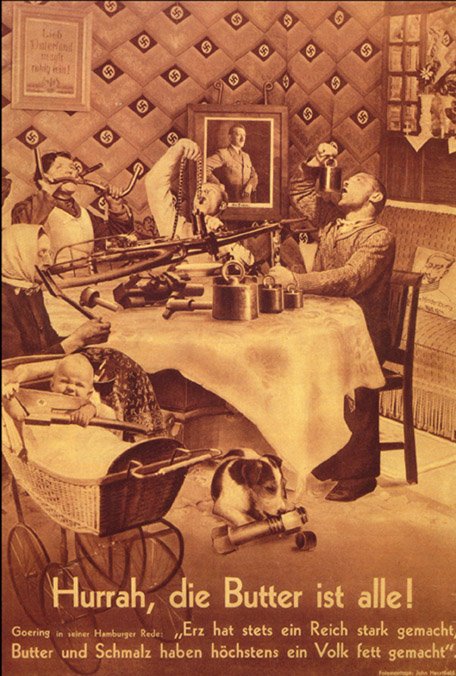If we eat iron it will make us strong. Political satire of the most biting. But satire by nature accepts and is somewhat complicit in the forces that brought what is being critiqued to the fore. The Dadaism of which Heartfield was a part, represented an equal break from the past and in a sense as Marcel Duchamp conceptualized, Dadaism was part of a nihilism as well, an artistic scorched earth policy that took no prisoners and was ready to discard the accumulation of past experiences to the scrap heap. A Germany that is inert, deflated and banal. There is a sadness to the ridicule marked by an absence of angry vigor; something that marks fascism’s deadening hand on Germany. The only way out in representation was a dream like absurdity found in the ironic mock poetic photomontage.
This work is Heartfield’s most famous, it is the climax of the artist’s mastery of the genre. A German family is depicted eating various parts of a bicycle, with Hitler’s portrait and swastika wallpaper in the background. The quote is from Herman Goring, and it reads: “Iron has always made a nation strong, butter and lard have only made the people fat”. In his work, Heartfield parodied the style of Nazi propaganda posters to criticize the regime. Heartfield’s work was of course a type of propaganda in itself, but his work expressed the discontent of the opposition in Germany. Deeply cynical, his works resonated with the readers of AIZ, and was a potent glimpse into the struggle in Germany for those on the outside.Read More:http://musingsofanartstudent.blogspot.ca/2010/12/artist-review-17-john-heartfield.html
Its a magic realism that captures a society a dying Weimar that is no longer wildly chaotic and absurd, a piece of Germany that is no longer spinning out of control and full of contradictions. There is a bitterness in its death, but it is a futile visual gesture that knows it cannot stop events. Its also an art that relies exclusively on mechanical reproduction: the anti-esthetic that became an enduring avant-gard esthetic.

---How Crooked are your Branches. 1934---Read More:http://communication.ucsd.edu/goldfarb/cocu108/data/notes6.html
Strange, unfathomable human forces seemed to be informing and shaping social reality, a bizarre coherence of the fantasy that only the photographic image could do justice. How could a half-wit pervert and gang of thugs change human history? This is the dream-like absurdity, unreality true to reality. A whole, complete ugly dream that implied that society was a mad dream, that humans were now equal to animals so killing them was no different than slaughtering animals, and intellectuals who should know better like Walter benjamin were abetting this reasoning with ideas that we should return to an animal condition; a romantic puritism corrupted by Darwin and Spinoza. Reality was so insane it has to be a dream. And these fantasies were not manufactured but mundane, banal reality. The routine, with fantasy and reality being indistinguishable. No boundaries. In the fiction of Heartfield’s art, he was simply trapping the character, fantastic as it seemed, of reality.
ADDENDUM:
So do Grass’ views reflect mainstream German thought, or don’t they?
Grass’s principal parliamentary support came the German Left party deputy Wolfgang Gehrcke, who serves as the party’s foreign policy spokesman.
He said Grass has the “courage” to say what is silenced. In the past Gehrcke has participated in pro- Hamas and pro-Hezbollah rallies and has compared Israel to Nazi Germany.
Unsurprisingly, the Left Party has struggled over the years to recogn
Israel’s right to exist. While the anti-fascist Left party spokesman celebrated Grass, the extreme right-wing fascist party—the National Democrats (NDP)—also praised the author. Günter Grass has earned credit for his “liberating break of a taboo” by criticizing the “aggressive Jewish state,” wrote the NPD Saxony state politician Jürgen Gansel.
I think we can safely say that after 70 years, the Germans still don’t know how to respond to the Holocaust and do so with a mixture of continued anti-Semitism on the one hand, and shame on the other. Perhaps this sums it up best:
German debates over anti-Semitism after the Holocaust have traditionally been anchored in guilt and shame, and in that department, Grass is no anomaly. The German writer and director Rainer Werner Fassbinder neatly captured this phenomenon in his 1975 play “Garbage: The City and Death,” in which the character Hans von Gluck bemoans, “And it’s the Jew’s fault, because he makes us feel guilty because he exists. If he’d stayed where he came from, or if they had gassed him, I would sleep better.”
Which may help to explain Grass’ peculiar obsession with Israel. Henryk M. Broder, a best-selling German author and critic of Grass, argues that the debate has transformed Germany’s Nazi-era slogan “The Jews Are Our Misfortune”’ into “Israel Is Our Misfortune.” Read More:http://israelmatzav.blogspot.ca/2012/04/which-germans-support-gunter-grass.html
————————–
Response to Donald Kuspit:If the case existed (neither I nor those I’ve consulted have found any evidence of it), its German judge was the Weimar equivalent of the New York Supreme Court Judge “turn ‘em loose Bruce” Wright of the 1970s. And who was the “famous” Dada artist or artists? The Jew Tristan Tzara, the Communist George Grosz or the diminutive Helmut Herzfelde, a.k.a. John Heartfield — who in utter disgust for the Kaiser’s militarism anglicized his name after WWI and who depicted the Nazis, Hitler, Göhring, et al, in unflattering situations? Cowards, you say. Yes, I suppose in the end they were cowards because they did choose to flee (an instinct we share with other species when they or we feel threatened). Read More:http://www.toutfait.com/issues/issue_2/Notes/barowitz.html









 COMMENTS
COMMENTS



